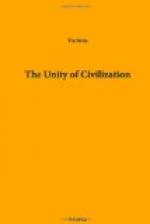The recorded movements of peoples in historic times, and the previous movements inferred from language, and other symptoms, indicate a long-established distribution of what might be described in meteorological phrase as man-pressure; certain regions being characterized either always or repeatedly by high man-pressure, and an outward flow of men into the cyclonic areas or vortexes of low man-pressure in the human covering (or biosphere) of the planet. Typical high-pressure regions are the Arabian peninsula with its repeated crises of Semitic eruption, and the great Eurasian grasslands. Typical regions of low man-pressure, and repeated irruption, are the South European peninsulas. Occasionally a region plays both parts, alternately accepting inhabitants, and unloading them on to other lands; examples are the Hungarian plain, Scandinavia, and Britain. Others again can hardly be said to have a population of their own at all, but are simple avenues of transmission, like Western Switzerland and the Hellespont Region. I am speaking now, of course, about ancient times. The causes of these recurrent movements are not clearly made out; but the movements themselves, and the fact that they are of regional recurrence, are matters of history.
Conspicuous among such movements are the westward drift from Asia into peninsular Europe, in its three parallel columns, through tundra, forest, and steppe; and the southward drifts, subsidiary to this, from East Central Europe into the Balkan lands and round the head of the Adriatic. The course of these drifts is laid out in detail, as we have seen, by the physique of the regions; and therewith is determined the kind of life which each set of folk must be living if it is to survive the journey.
And here we come at once upon a new factor making strongly for a more general uniformity of culture within peninsular Europe than its physical character would at all prepare us to expect. For although individual men often respond very rapidly to fresh surroundings, and can change their mode of life almost as they change their clothes, societies react far more slowly; at the pace, in fact, usually of their most obstinate members. Confronted therefore with the opportunity, or the need, for a change of habit, in the course of a migration for example, they must either refuse it, like a shy horse, or (if they accept it) enter on their new career imperfectly trained, and extemporizing adjustments here and there in very unworkmanlike fashion. Only rarely does the statesman or ‘lawgiver’ appear, just when he is wanted, to bring Israel up out of Egypt into the desert, and out of the desert into the good land beyond Jordan, and to canonize a new code of behaviour suited to a new set of needs. This social inertia, of which political history is the sorry record, is of course least perceptible, and most effective, when the region of transition is graduated gently; and we have already seen that this is conspicuously so around the parkland margin of the northern grassland, where it faces on peninsular Europe. Let us follow this clue in detail.




